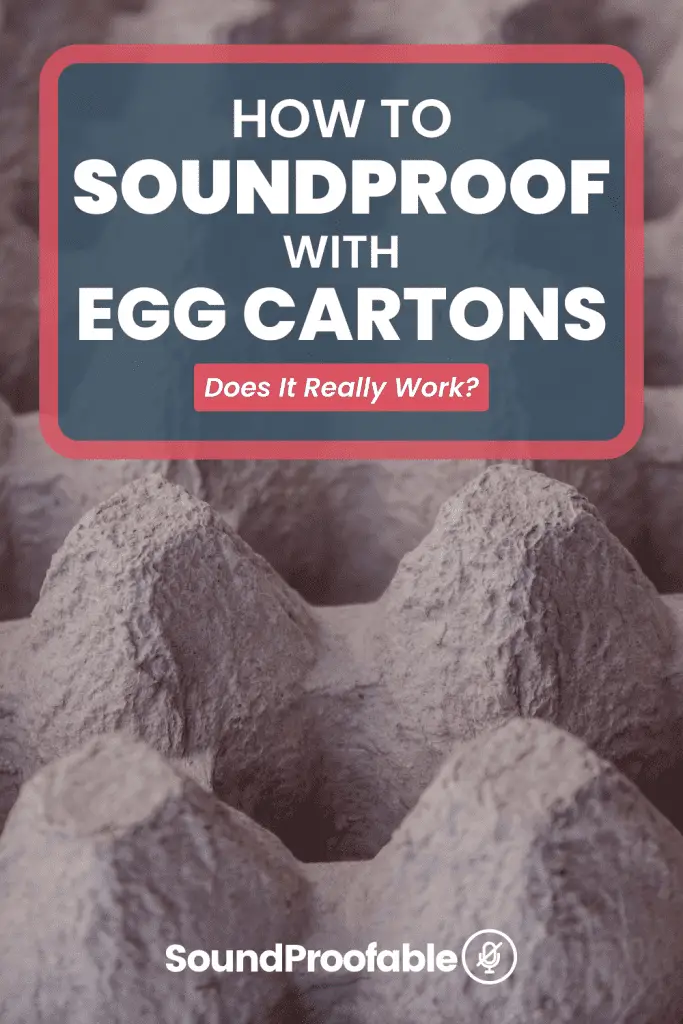If you’ve ever been down the soundproofing rabbit hole on YouTube then you might have seen people recommending egg cartons as an effective way to soundproof a room.
While it’s true that they can help to reduce the overall level of noise in a space it turns out, that this common household item might not be as effective as you thought. In fact, it might not do much at all!
Read on to find out if soundproofing with egg cartons really works.

Is Soundproofing With Egg Crates A Myth?
Now if your problem is to do with echoes in your space, you can consider egg cartons. Echoes are created when sound bounces back and forth the walls making them loud and echo.
Egg crates may help dampen the sound by forcing them to bend around them and scatter across the room.
Egg cartons can reduce some noise that is being created in that room, but reducing the outdoor noise with these little things can be a waste of time and energy. But obviously, it is not a practical idea to place egg crates against the wall.
What Is The Logic Behind Soundproofing?
We believe the myth of egg cartons for soundproofing come from acoustic panels shaped like egg cartons.
That similar surface position is there for a good reason it prevents an echo. Such acoustic foam is engineered with dome and valley shapes like egg cartons to diffuse sound.
An acoustic sound absorbent material must have small “pores or atoms” in them to move in 3-dimension. Thus when a sound wave hits them, the kinetic energy changes to heat energy within the material.
Thus the perfect acoustic material is thick, soft and open-celled foam that contains millions of small bubbles. Egg cartons are made of recycled paper, foam or plastics. And none of these materials have the acoustic properties of dense paper fibers.
Plus they are usually a soft material that is meant to protect fragile eggs. They are usually about 40-70 mils which are not thick enough to make them acoustic.
Tested for noise reduction, Egg crates score 0.4 on the Noise Reduction Coefficient which means that 40 percent of the sound waves are absorbed by the material. Compare this to a two and a half-inch thick acoustic egg crate foam which scored a 0.60 on the NRC scale.
Making Egg Crates A Bit More Effective
If you really want to try using egg crates, you will have to do extra work in these ways:
- Add soft materials between the crates and the walls, or over the crates: Add to the thickness of the egg crate by placing blankets or pillows between them and the walls Or you could use the crates in between your walls instead of leaving your walls hollow.
- Make the egg crates less hollow with scraps of paper or fabric: You can use any glue or paste to keep scraps of fabric or paper inside the hollowness of the egg crates. This increases the density and thickness of the crate improving its sound absorption and giving you a flat side to attach to the walls.
- Combine the egg crates with other more effective solutions: For example, if the speaker in your room is the source of the noise, you could lower the volume and place egg cartons in the gap between the door and outside. This seals the air gaps and prevents sound from leaving the room to a degree.
Better Alternatives to Egg Cartons
1. Use Soundproof Curtains
This solution also may sound like a myth but we can safely say that this definitely works. Unlike ordinary cotton or plastic curtains, soundproofing curtains are made of special material.
They prevent sound from leaving the space and noise from outside from entering. They are easy to install into eyelets and can be chosen in a color that matches your aesthetics.
2. Place Some Soundproof Blankets
Soundproofing blankets or moving blankets work by absorbing sound. They can prevent outdoor noise from getting in and the sounds from inside from going out.
Being thick and massive, you might need help with placing these on your walls. They will also need to be washed from time to time.
3. Use A Weatherstrip On Your Doors
A weatherstrip is a tool that seals the space between the floors and the doors. This works by blocking the incoming noise from outside and prevent thermal leaks. I cannot say that this method can soundproof the door completely but this is an easy solution.
4. Anti-Vibration Pads
Anti-vibration pads work in a similar manner as acoustic foam panels. These pads are thick with wrinkles on both sides and can absorb low-frequency noise. They have been proven to prevent outgoing and incoming noise when placed against the walls.
5. Replace irritating noise with White Noise
If you can’t get rid of the noise, masking it with a white noise machine is the last solution. They produce a frequency that stimulates the brain and helps you ignore the irritating sounds. These machines are affordable and can be a temporary solution to your problem.
6. Acoustic Panels
Acoustic panels are soundproofing foams that are usually open-celled. They reduce increase air resistance thereby reducing the amplitude of sound waves.
They can be glued or installed on your walls to soundproof your space by a great deal. If you’re serious about decreasing the sound that enters and exits your space, skip the egg cartons.
Another important reason we would advise against using egg crates is due to their flammability. They are quick to alight and spread fires pretty quickly.
Final Thoughts
Soundproofing is not a difficult job its easy and with some knowledge, you could even DIY the process. Also, there are so many affordable options available online. Stick around my blog and you will definitely find a more practical solution.
